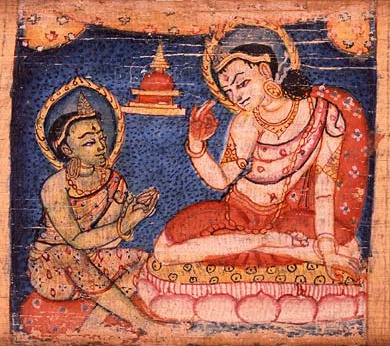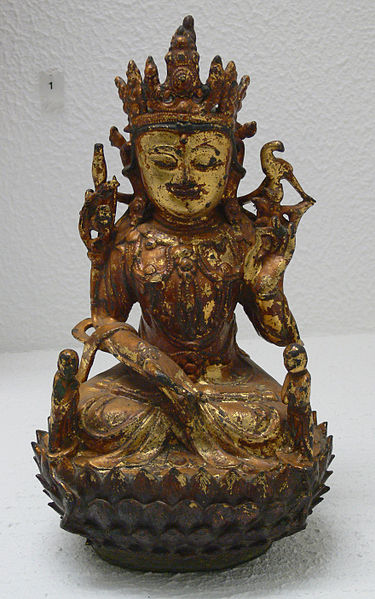Gandavyuha Sutra
The Gandavyuha-Sutra ( (Skt. Gaṇḍavyūhasūtra, Wyl. mdo sdong po bkod pa; Sutra of entry into the area of reality) of the Ekayana is regarded as a forerunner of the Avatamsaka Sutra, into which it was integrated as chapter 39.
An inscriptional text of it accompanied by paintings can still be found today on the temple walls of the monastic complex at Tabo dating to the tenth century.
Scenes depicting the complete narrative of the Gandavyuha Sutra were carved into the gallery walls of Barabudur in the indonesian island Java.
The original Sanskrittext from the second century had chinese translations(chin. Dàfāngguǎng Fóhuáyán Jīng, Huayan jing) and a tibetan translation(wyl. mdo-phal-po-che ) in the 9th century and nowadays english translations of japanese translations of the original sanskrit as chapter 39 of the Kegon-Sutra (jp. Daihōkō Butsu-kegon Kyō; Hua-Yen-Sutra , Avataṃsaka-sūtra) u.a... The translations of Thomas Cleary are from chinese translations and not as original as the Kegon - translations.

Sudhana and Manjushri
The Gandavyuha-Sutra is a Mahayana - text with the bodhisattva - ideal. It includes the pilgrimage of a pilgrim named Sudhanakumâra to 52 spiritual friends (kalyanmitra) and counselors with the goal of the cosmic enlightenment of the highest bodhisattvas.
(Sudhanakumâra ('Child of wealth ; Shàncáitóngzǐ; Wade–Giles: Shan-ts'ai-t'ung-tzu) is in China better known as Sudhana('Red boy') and as Shancai or Shancai Tongzi.)
The sutra spread in the asiatic region until Borobudur in Indonesia. In the chinese version of the sutra, Sudhana is sometimes being assigned to Longnü, the daughter of the Dragon King, who does not appear in the Sanskrit-Version of the sutra.
Picture : Guanyin in Bodhisattva jewelery, at her knees on the Lotosthron Shancai (Sudhana) and LongNü (daughter of the dragonking 'long wang', who lives at the bottom of the 'sea' ). She can be looked at as the awakened und cleaned prana-kundalini of the aspirant .

Guanyin in Bodhisattva jewelery on the Lotos - throne; at her knees Shancai (Sudhana) and Longnü (daughter of the dragonking long wang)
The sutra became one of the fundamental texts of the chinese Hua-Yen scool.
From the Yuandun jiao - sect (of the late Ming), which was founded by Zhang Hao, comes a threefold division of the above 52 steps :
- Asamkhyeya : (from the 11. to the 40. transmission)
- Asamkhyeya : (from the 41. stage to the 47. stage )
- Asamkhyeya : (from the 48. stage to the 52.)
After this is step 53, the Samyaksambodhi (absolute universal enlightenment), the last miraculous enlightenment of Samantabhadra, comparable with the Sahaj-Samadhi.
The word gaṇḍa has also the meaning of 'language with double meaing'. Already D. T. Suzuki proposed to look at the Gandavyuha - Sutra as description of the unfolding and expanding consciousness of a seeker.
The Sutra describes steps 1 to 19 auf the universal path in a secret language embedded in stories.
1 - 27 (Avalokiteshvara) are equivalent to steps 1 - 12.
28 - 53 are equivalent to steps 13 - 19.
== Literature ==
- Fontein, Jan (1967). The pilgrimage of Sudhana: a study of Gandavyuha illustrations. Walter de Gruyter. ISBN 978-3-11-156269-8.
- Entering the Dharmadhātu: A study of the Gandavyūha reliefs of Borobudur. Jan Fontein. Brill, Leiden 2012, ISBN 978 90 04 21122 3.
- Entry into the realm of reality. A translation of the Gandavyuha, the final book of the Avatamsaka Sutra / translated by Thomas Cleary. ISBN 0877734844; 9780877734840
- Cleary, Thomas. The Flower Ornament Scripture 3, Entry into the Realm of Reality / Transl. by Thomas Cleary. Boulder: Shambhala, 1987
- Der Bodhisattva-Weg im Gandavyuha - Sutra (de - not deep enough)
- Pro - tantric elements in the Gandavyuha sutra
- Sudhana's miraculous journey in the temple of the Ta pho: the inscriptional text of the Tibetan Gaṇḍavyūhasūtra edited with introductory remarks, Ernst Steinkellner, Istituto italiano per il Medio ed Estremo Oriente, 1995
- Paths to liberation , studies in east asian buddhism 7
== Links ==
- Gutenberg Project : Gandavyuha Sutra
- Ctbusa - translaton: Entering into the dharma realm
- Wiki about the Gandavyuha Sutra
- Spiritwiki.de : Gandavyuha Sutra
- Gandavyuha Sutra : List of teachers
- Borobodur reliefs
of Spirituality
universal-path.org